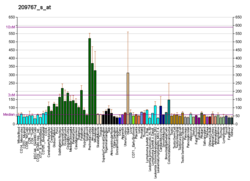Septins are a group of GTP-binding proteins expressed in all eukaryotic cells except plants. Different septins form protein complexes with each other. These complexes can further assemble into filaments, rings and gauzes. Assembled as such, septins function in cells by localizing other proteins, either by providing a scaffold to which proteins can attach, or by forming a barrier preventing the diffusion of molecules from one compartment of the cell to another, or in the cell cortex as a barrier to the diffusion of membrane-bound proteins.

Chemokine ligand 7 (CXCL7) is a human gene.

P2Y purinoceptor 1 is a protein that in humans is encoded by the P2RY1 gene.

Syntaxin-4 is a protein that in humans is encoded by the STX4 gene.

Platelet glycoprotein Ib alpha chain also known as glycoprotein Ib (platelet), alpha polypeptide or CD42b, is a protein that in humans is encoded by the GP1BA gene.

Glycoprotein Ib (platelet), beta polypeptide (GP1BB) also known as CD42c, is a protein that in humans is encoded by the GP1BB gene.

Septin 2, also known as SEPT2, is a protein which in humans is encoded by the SEPT2 gene.

Septin-9 is a protein that in humans is encoded by the SEPT9 gene.

Solute carrier family 23 member 2 is a protein that in humans is encoded by the SLC23A2 gene.

Septin-4 is a protein that in humans is encoded by the SEPT4 gene.

Phosphofructokinase, platelet, also known as PFKP is an enzyme which in humans is encoded by the PFKP gene.

T-complex protein 1 subunit theta is a protein that in humans is encoded by the CCT8 gene. The CCT8 protein is a component of the TRiC complex.

Septin-6 is a protein that in humans is encoded by the SEPT6 gene.

Septin-7 is a protein that in humans is encoded by the SEPT7 gene.

Septin-8 is a protein that in humans is encoded by the SEPT8 gene.

Hermansky–Pudlak syndrome 5 protein is a protein that in humans is encoded by the HPS5 gene.

Serine/threonine-protein kinase PFTAIRE-1 is an enzyme that in humans is encoded by the PFTK1 gene.

Septin-11 is a protein that in humans is encoded by the SEPT11 gene.

Rho-related BTB domain-containing protein 2 is a protein that in humans is encoded by the RHOBTB2 gene.

Cell migration-inducing and hyaluronan-binding protein (CEMIP), formerly known as KIAA1199, is a protein that in humans is encoded by the CEMIP gene. CEMIP has been shown to bind hyaluronic acid and catalyze its depolymerization independently of CD44 and hyaluronidases. Such function has been also been validated in mice.






















